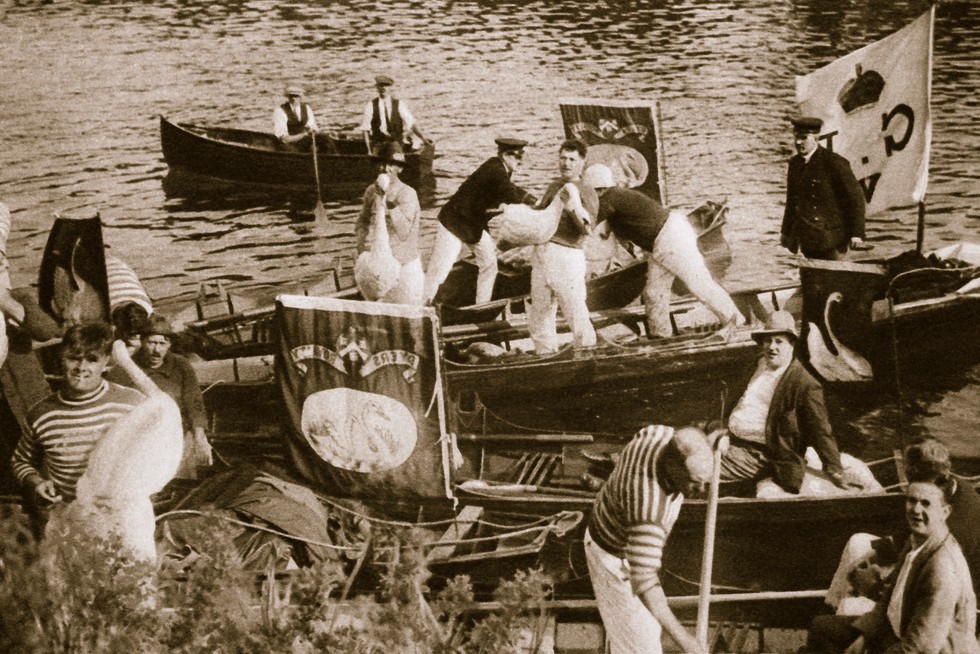Does the Warden of the Swans exist – and does the royal family own all the swans in Britain?
Does the monarch really own all the swans in Britain? How true is it that killing one is an act of treason? Explore the roles of Warden and Marker of the Swans

Among the thousands in the employ of the royal household, some have peculiar job titles – as evidenced in episode six of the The Crown season 6, which sees an exasperated Tony Blair, hoping to improve the monarchy's reputation, question the need for a 'Warden of the Swans' .
There’s the shoe-wearer to wear in a new pair for the monarch’s feet; the official harpist to the Prince of Wales; and the Piper to the Sovereign, alert every weekday at 9am to play bagpipes underneath the royal bedroom window.
Most have a long and colourful history, and the dual roles of Warden of the Swans and Marker of the Swans are no different. Yes, the Warden of the Swans really does exist.
How old are the roles of Warden of the Swans and Marker of the Swans?
These specific job titles are actually just 30 years old. In fact, there has only been one serving Warden and one Marker: Professor Christopher Perrins LVO and David Barber MVO respectively. It was in 1993 that the much-older post of Keeper of the Swans split into these two positions.
The post of Keeper of the Swans dates back to the 13th century. With swan considered a delicacy for a medieval banquet, their numbers were routinely checked to ensure an ongoing supply to the royal table. In 1247, for instance, Henry III ordered 40 swans for his Christmas celebrations.
Only certain people and institutions – the wealthiest ones – could own swans other than the monarchy, and the royals could be highly protective of their swans. Elizabeth I went to court in 1592 over the ownership of 400 of the birds in Dorset. To manage the population, the role of Keeper carried on throughout the centuries.
What do the Warden and Marker of the Swans do?
Today, their main job is to coordinate the ‘Swan Upping’, an annual census on a stretch of the River Thames. While this practice long held more ceremonial value than anything else, now there is greater emphasis on conservation and education to protect swans’ habitats.
The Warden and Marker’s responsibilities also include monitoring the health of the swan population, advising organisations that use the waterways, working with swan rescue groups, and supervising the temporary removal of swans from the Thames in preparation for boating regattas.
What happens at the Swan Upping?
Every July, a group of Swan Uppers – wearing scarlet shirts bearing the cypher of the monarch, and led by the Marker in their scarlet jacket and hat with a swan’s feather – row traditional skiffs from Sunbury on Thames to Abingdon Bridge, covering nearly 80 miles and taking five days.
When they spot a swan with newborn cygnets, the Uppers cry “All up!” and encircle the birds in their skiffs, before lifting them onboard and checking their health.
In July 2023, the first Swan Upping in the reign of Charles III, 94 cygnets were checked, compared to 155 in the previous year – a drop thought to have been caused by a Bird Flu outbreak.
Des the monarchy own all of Britain’s swans?
That’s the well-worn urban legend, and there is a grain of truth to it (there is none, however, to the other one about killing a swan being an act of treason).
The monarch has the right to claim ownership to any mute swan – the all-white, orange-beaked version – in the open waters of Britain, but in practice they exercise this right only in the Thames around Windsor.
There are three organisations who can also own swans, thanks to historic grants. These are Abbotsbury Swannery and the London-based livery companies – the Vintners and Dyers – who send representatives to the Swan Upping every year.
Yet, it is only the monarch who holds the title of ‘Seigneur of the Swans’.
The real history behind The Crown
Want to know even more about the real events from history that inspired the drama? Read more from the experts…- Thatcher and Queen Elizabeth II: what was their relationship like?
- Prince Charles and Camilla: a history of their romance
- Why did Charles and Diana's marriage fail?
- The Queen’s “rebel sister”: 8 facts about Princess Margaret
- Buckingham Palace intruder Michael Fagan: what happened and why did he break in?
- Was the Queen opposed to the Falklands War?
- Princess Diana and Prince Charles’s wedding: everything you need to know
- Why was Lord Mountbatten, Prince Charles’s great-uncle, assassinated?
- Everything you need to know about Prince Charles
- Who is Camilla, the Duchess of Cornwall?
- Princess Margaret and Lord Snowdon: why did their marriage break down?
- Queen Elizabeth II and Prince Philip: 8 milestones in their marriage
- Who is Princess Anne, daughter of Queen Elizabeth II?
Authors

Jonny Wilkes is a former staff writer for BBC History Revealed, and he continues to write for both the magazine and HistoryExtra. He has BA in History from the University of York.

Start the year with a subscription to BBC History Magazine - £5 for your first 5 issues!
As a print subscriber you also get FREE membership to HistoryExtra.com worth £34.99 + 50% London Art Fair 2024 Tickets




